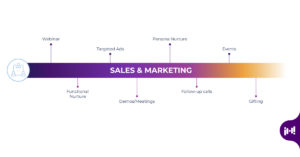Reporting on account based marketing ROI is a key challenge for marketing organizations. Here’s how to measure account based marketing, including foundational guidelines and key reports.
—
The ability to understand and communicate the value of your marketing efforts as they relate to your organizational goals is fundamental for business growth. Yet, in our recent survey of marketing leaders from B2B tech organizations, 71% of respondents cited improving marketing’s ability to report on ROI as a top initiative for 2022—and 61% agreed or strongly agreed that difficulty measuring account based marketing ROI is a challenge.
71% of respondents cited improving marketing’s ability to report on ROI as a top initiative for 2022.
Some of the challenges with reporting on account based marketing ROI (and overall ROI) stem from not having a well integrated tech stack. Others come from poor martech platform setup, while more come from the chosen metrics. For account based marketing (ABM), where marketing and sales work in unison to drive key opportunities down the funnel, connected reporting is key. This means having integrated technology, unified dashboards between sales and marketing, and full transparency around awareness and influence.
What account based marketing measurements should I consider?
Any marketing measurement and especially account based marketing measurement, should focus on four primary areas:
- Readiness. Assessment of the level of preparedness to move the program or tactic forward.
- Activity. Measurement of activities that the organization believes will drive the output it seeks.
- Output. Measurements taken while delivering outputs.
- Impact. Measurement of actual output against specific business goals.
Together, these measures can help marketers define what the organization is trying to achieve, and understand where it is succeeding, where it’s falling short, and why. In addition, frequent reporting is crucial for long-term success because it allows you to quickly identify and resolve issues across sales and marketing, and stay in alignment with goals.
How to measure account based marketing ROI.

The north star of account based marketing is to drive unified account conversations. While much is made of the value of marketing and sales alignment, aligning on ABM measurement is a vital, but often overlooked, step. Follow these guidelines to lay the foundation for effective reporting that drives account based marketing ROI.
- Agree on goals. Marketing and sales teams do not perform the same function but they should not be thought of as separate entities. Both groups need to align on the goals for your account based marketing program and how those goals will be measured. It’s also important to talk through how the actual business processes for achieving those goals are different from those used in broad-based demand generation.
- Use the EXACT same reports. Using different reports does not accomplish the goal of ABM, which is to combine skills, knowledge, and resources to achieve common goals. One mistake we often see is marketing and sales each looking at their own version of the “same” report. If it comes from different systems or if it is built using different criteria (e.g. time frame, definition), it’s not exactly the same, and can lead to gaps and misunderstandings. ABM must be an integrated initiative with integrated reporting.
- Reinforce the account vantage point. Reports should add to your knowledge about an account in ways that move it from awareness to closed and beyond. For this to happen, you need to pull reports at the account level, not the person level. One way to make sure this happens is to only use contacts instead of leads in your CRM.
- Choose your reports wisely. The key reports you create should provide everyone with everything they need in terms of account information, sales motions, and outcomes. You will likely want and need additional reports, but there are 5 must-have reports that you cannot leave out of your ABM strategy.
5 must-have reports for ABM measurement.
Report #1: Account List.
Owner: Sales
Location: CRM
Frequency: Semi-quarterly
The account list is exactly what it sounds like: a report that shows all of the organizations that you explicitly state are in your ABM account list. Although this may seem basic, this report helps ensure teams are aligned on your ABM strategy and what type of organizations you are or are not including in that strategy.
Your account list will not be static. Make sure everyone on your growth team is always working off the latest version by managing this report in your CRM system. This way, one change in the CRM will update any other instances of the information within your tech stack. Additionally, this is an “always-on” kind of report. Update it as needed, but also include a semi-quarterly review process to allow for significant change.
Tip: Avoid presenting an overall aggregate of this report, as that can be overwhelming. Instead, filter your account list by representative, first line sales manager, or particular region or industry.
Report #2: Intent Data.
Owner: Marketing
Location: Associated with accounts in your CRM
Frequency: Weekly
Intent data is 1st and 3rd party information that provides a picture of the intent, or buying readiness, of an account, based on engagement activity by members of the buying team. Intent data doesn’t completely eliminate the sales and marketing guessing game. But it can help both teams prioritize and optimize their efforts. For example, sales can use information about which accounts are actively engaging with content related to your solution to refine the target account list. Insight into which personas are actively engaging can improve understanding of the buying team dynamic. Sales and marketing can also use engagement insights to inform outreach and drive campaigns.
While marketing owns this report, it’s critical that sales accesses, understands, and uses this data regularly. Because intent data is really deeper account information, it should be associated with accounts in the CRM and reviewed on a weekly basis so marketing and sales always know where they currently stand with accounts.
Tip: For the most complete picture, layer intent data from multiple sources. At a minimum, you’ll want to integrate 1st and 3rd party intent data from top of funnel and middle of funnel engagements.
Report #3: ABM Dossier.
Owner: Individual sales reps
Location: Shared document
Frequency: Continual
This is one you’ll need for each and every one of your ABM accounts. Owned by individual sales reps but used by both marketing and sales, the account dossier is a record of everything your teams know about the account, including:
- Firmographics, like size and industry, as well as clientele (your audience’s audience)
- Who you believe to be in the buying team (job titles, names, role, interests/needs)
- Which people to engage (decision makers, practitioners, influencers)
- A running record of all known touch points with the account—including the channels in which sales has engaged with members of the buying team, who they’ve connected with, and what they know about the needs of those buying team members.
The value of this report is in the aggregation of information. It allows marketing to inform sales and sales to inform marketing. It’s much easier to determine next steps when you can see where and how accounts have engaged! To deliver that value, the document owner must keep the dossier up-to-date and both marketing and sales should consult it regularly to inform outreach.
Tip: In addition to driving more personalized and fruitful engagement with a specific account, account dossiers help you understand how buying teams at similar accounts make buying decisions—and put that information to work to drive more effective engagements with current opportunities.
Report #4: Sales Motions.
Owner: Sales
Location: Sales engagement or marketing automation platform
Frequency: Continual
ABM programs often fail when reps take shortcuts with sales motions. The sales motions report provides a picture of what the sales team is doing to engage an account. Ideally, your systems should automatically generate the content for this report — call logging and email tracking. At a minimum, it should include a history of sales engagements with the account, including:
- Emails sent
- Outbound telephone calls made
- First or intro meetings set up and completed
- People engaged
This report also powers the last report on this list: planned versus actual.
Tip: Make sure to include links to the specific emails sent within the report, so that you have a record of your exact messaging. For example, if you perform five introduction meetings, you should be sending five customized emails; record and directly link each of these in the sales motions report.
Report #5: Planned vs. Actual.
Owner: Marketing and sales
Location: Spreadsheet or dashboard
Frequency: Quarterly
The planned vs. actual report documents the marketing and sales activities that both teams agreed on and committed to for the last quarter, compared to what actually happened during that time. For example, your marketing plan may include delivering personalized webinar experiences to three specific accounts with a goal of driving a certain number of engagements with the contacts at those accounts. Without a record of what actually happened, there’s no way to evaluate either the effectiveness of the plan or the team’s performance.
After the accounts list, the planned vs. actual report is the second most important report in this list. Why? ABM is a whole new way of engaging prospects—one that is new for both marketing and sales. This report provides a crucial checkpoint to make sure everyone is going in the right direction and, if not, inform a course correction. For example, focusing too heavily on decision-makers leads to missed opportunities to engage with practitioners — a lesson ABMers can learn from developer marketing.
It combines information from both marketing and sales platforms. You can create it in a spreadsheet, dashboard or other program.
Tip: It’s important to include both leading and lagging indicators in the planned vs. actual report. Leading indicators are measures that help determine whether you’re taking the right motions and participating in the right activities. (The example above is a leading indicator.) Lagging indicators deal with conversions in the pipeline. They compare what you thought you’d be able to drive via the ABM initiative vs what you actually drove.
The Iron Horse insight.
The ultimate goal of account based marketing reporting is to see what’s working, what’s not, and why—and then use that information to make real-time adjustments to marketing and sales motions. These reports will help drive ABM ROI—but only if they are kept accurate and up to date, reviewed frequently, and both marketing and sales teams know how to use them to accelerate opportunities with target accounts.
Wondering how to get your teams on the same page with ABM analytics and measurement? Learn why you need to change your data mindset to scale ABM in this short video from our ABM Foundations video series.



